SRM-AP All News
ALL News
- A Blockchain-Based Peer Tutoring Platform January 28, 2025
 In a rapidly changing educational landscape, innovative solutions are key to enhancing learning experiences. Ms Naga Sravanti’s patent on A System for Implementing a Peer Tutoring Platform, introduces a blockchain-based peer tutoring platform designed to tackle challenges in traditional education.
In a rapidly changing educational landscape, innovative solutions are key to enhancing learning experiences. Ms Naga Sravanti’s patent on A System for Implementing a Peer Tutoring Platform, introduces a blockchain-based peer tutoring platform designed to tackle challenges in traditional education.As we explore the implementation and societal implications of this platform, its potential to democratise education and create valuable connections among learners worldwide becomes evident. Join us in examining this innovative approach and its promising future research directions.
Abstract
This research presents a blockchain-based peer tutoring platform designed to enhance the quality and accessibility of education. By utilising blockchain’s decentralized and transparent features, the system ensures secure transactions, reliable certification, and the equitable management of peer tutoring activities. The platform aims to foster trust among users by recording all interactions and achievements on an immutable ledger, addressing critical challenges like data manipulation, lack of accountability, and accessibility issues in traditional education systems.
Explanation in Layperson’s Terms
Imagine a platform where students can teach and learn from each other without worrying about unfair practices or lack of credibility. This system uses blockchain, a technology that keeps records safe and transparent so that everyone can trust it. For instance, when a student tutors someone else, the system records this in a way that no one can alter. Certificates issued for achievements are also tamper-proof, making them reliable for future use. It’s like having a digital notebook that no one can tear a page from or erase anything written in it. This platform creates a fair and secure space where students and educators can collaborate effectively.
Practical Implementation and Social Implications
The peer tutoring platform has immense potential to revolutionise education:
Equity in Education: Students from diverse backgrounds can access quality tutoring at affordable costs or through a mutual exchange of knowledge.
Trust and Credibility: Blockchain’s secure system ensures that all records of learning and certifications are genuine and cannot be tampered with.
Recognition of Effort: Tutors can build verified portfolios showcasing their expertise and contributions, which can be used for job opportunities or further education.
Global Collaboration: Learners and educators worldwide can connect, exchange knowledge, and grow together, breaking geographical barriers.
Collaborations
This research has benefited from partnerships with educational institutions, blockchain developers, and organizations promoting innovative learning methodologies. Collaborators include academic peers at SRM University-AP and technical support from blockchain technology firms specializing in educational applications.
Future Research Plans
Building on this work, the following directions will be explored:
- Gamified Learning: Introducing game-like features to make learning more engaging and interactive.
- AI-Driven Personalization: Integrating AI to recommend the best tutors and resources for individual learners based on their unique needs.
- Scalability: Expanding the platform to accommodate millions of users globally without compromising speed or security.
- Real-World Deployments: Partnering with schools, universities, and governments to implement the system on a larger scale, bringing tangible benefits to communities.

Continue reading → - Sankranti Celebrations: Faculty and Staff Join for Festive Gathering January 27, 2025
 The Directorate of Human Resource Management organised Sankranti Celebration on a grand-level. The university Staff and faculty joined the festivities imbuing a sense of joy and community spirit, with shared laughter, games, and heartfelt interactions.
The Directorate of Human Resource Management organised Sankranti Celebration on a grand-level. The university Staff and faculty joined the festivities imbuing a sense of joy and community spirit, with shared laughter, games, and heartfelt interactions.One of the highlights of the festivities was the colorful Rangoli Competition, where participants showcased their artistic talents, adorning the campus with vibrant and intricate designs. The excitement continued with the exhilarating Pot Breaking (Matki Phod) event, followed by Tug of War putting their strength and camaraderie to the test, while also testing their physical prowess with the Sugarcane Breaking game.
Dressing in vibrant ethnic attire, our faculty and staff brilliantly embodied the spirit of the festival, enriching the occasion with their colorful presence and warmth. As the events unfolded, prizes were awarded to the winners, while also cherishing memories of togetherness reminding all of the importance of community and camaraderie.
The celebration marked as not just a harvest of ones’ agricultural abundance but also the harvest of togetherness and camaraderie.
Continue reading → - Prof. Lakshmivarahan’s Discourse on Data Mining vs Data Assimilation January 27, 2025
 The Department of Mathematics organised a guest lecture series by Prof. Lakshmivarahan, Professor Emeritus from the University of Oklahoma, Norman, USA on “Data Science and Big Data Analytics & Its Applications in Mathematics”. The conference featured dignitaries including Dean- School of Engineering and Sciences , Prof. C V Tomy and Head-Department of Mathematics, Prof. Kalyan Chakraborty. Around 30 students including Research Scholars, Masters and Bachelors students and around 4 faculty members were present during the lecture series.
The Department of Mathematics organised a guest lecture series by Prof. Lakshmivarahan, Professor Emeritus from the University of Oklahoma, Norman, USA on “Data Science and Big Data Analytics & Its Applications in Mathematics”. The conference featured dignitaries including Dean- School of Engineering and Sciences , Prof. C V Tomy and Head-Department of Mathematics, Prof. Kalyan Chakraborty. Around 30 students including Research Scholars, Masters and Bachelors students and around 4 faculty members were present during the lecture series.As part of the inaugural address, Dr Repaka Subha Sandeep, Assistant Professor and programme convenor emphasised the vital role of Artificial Intelligence, Machine Learning and Data Science in our contemporary society. He stated that, “This conference serves as a crucial platform for discussing the emerging trends and innovations in Artificial Intelligence and Machine Learning, reflecting its significance in various sectors today.”
The lecture series on “Data Mining vs Data Assimilation” discussed how data mining started in the early ages and how it evolved to the present ages. The lectures were based on the confluence of Artificial Intelligence and Data Science, wherein he discussed how data mining is being done in the present scenario. He then discussed what is data assimilation and how it can be understood by the fusion of mathematical models and data. Later he discussed what are direct and inverse problems which helps to understand the relationship between data mining and data assimilation. He further elaborated on the classification of mathematical models and the various types of data which arise in nature. Lastly, he discussed the estimation and optimisation of the problems brought forward in the lecture series.
The event concluded with the recognition of Professor Lakshmivarhan, Dean-SEAS, Prof. C V Tomy and Head of the department- Mathematics, Prof. Kalyan Chakraborty.
Continue reading → - International Mathematicians Assemble for the RAMRA Conference at SRM AP January 27, 2025
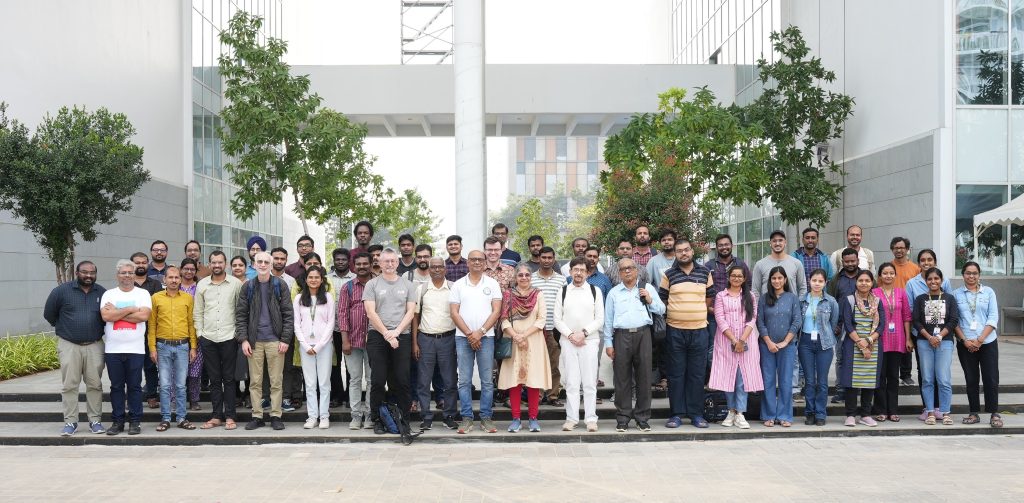
The Department of Mathematics organised the International Conference on Recent Advances in Mathematics and Related Areas 2025, from January 14 – 19, 2025, featuring the latest advancements in the field of pure and applied mathematics and theoretical computer science. The conference featured esteemed speakers like Fred Diamond (King’s College London), Ken Ribet (UC Berkeley), Jean-Marc Deshoulliers (University of Bordeaux), Gyula Katona (Alfred Renyi Institute Hungary), Olivier Ramare (CNRS France), Vita Kala (Charles University Prague) Mahan Maharaj, Anish Ghosh, Eknath Ghate (TIFR Mumbai), Apoorva Khare (IISC Bengaluru), U K Anandavardhanan (IIT Mumbai), Sukumar Adhikari (RKMVERI), B Ramakrishnan, Madhavan Mukund (CMI), Meena Mahajan (IMSc Chennai), Ken Ono (University of Virginia), and Anupam Saikia (IIT Guwahati).
The conference included sessions on topics and cutting-edge research on number theory, representation theory, Langlands program, geometry and topology, ergodic theory, lie algebra, diophantine approximation, modular forms, graph theory, combinatorial algebra, theoretical computer science, etc.
In his inaugural address, Dr Kalyan Banerjee, Assistant Professor and programme convenor from the Department of Mathematics, mentioned the importance of this conference in the research of mathematics and related areas. The Head of the Department, Prof. Kalyan Chakraborty talked about the history and relevance of this conference in the context of Indian and international mathematical communities.
On the last day of the conference, the Vice Chancellor of SRM AP, Prof. Manoj K Arora, SRM University-AP, hosted an interactive session with the distinguished speakers of the conference and other participants. In this interaction, the possibility of collaboration (both teaching and research) with different foreign universities was discussed.
The conference hosted 17 distinguished invited speakers from India and abroad and 8 young scholars. There were 40 participants from different research institutes in India, such as IISER, IMSc, CMI, and IITs. An upcoming conference proceeding will feature the articles of the invited speakers in association with Springer Proceedings. Additionally, the National Board of Higher Mathematics generously supported the conference.
Continue reading → - Women in Leadership: Two-Day ICSSR-sponsored Conference Come to a Successful End January 27, 2025
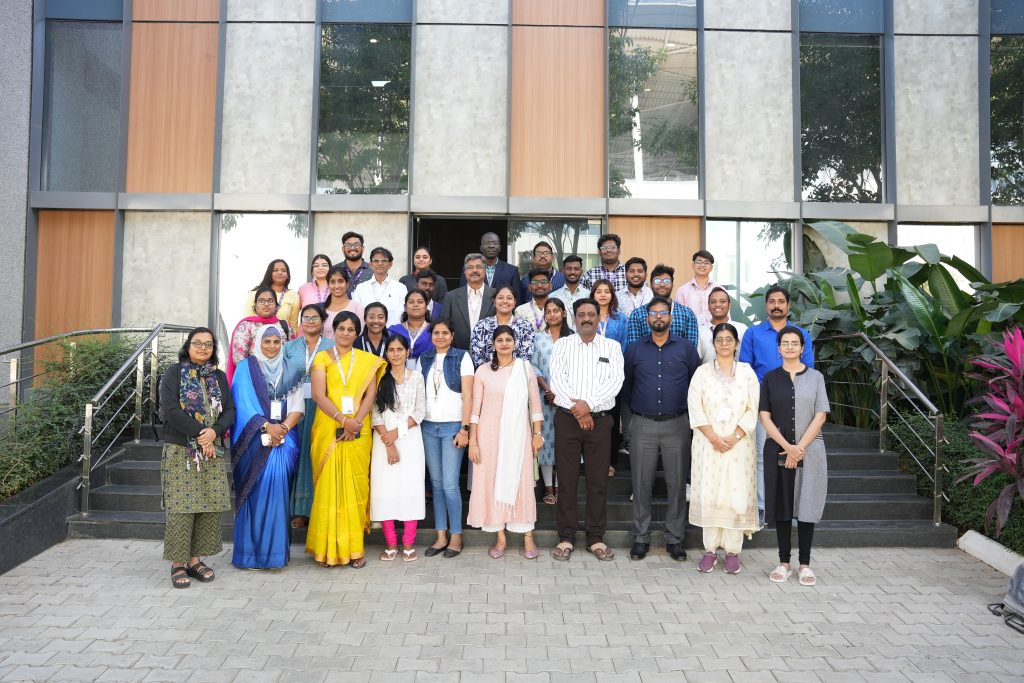
The Paari School of Business hosted its Two-Day ICSSR-sponsored National Conference on the theme “Women in Higher Educational Institutions (HEIs) and Career Progression” as part of the Vision Viksit Bharat@2047 initiative on January 23 – 24, 2025. This event brought together academics, delegates, and leaders to discuss research findings and actionable solutions for advancing gender equity in academia and leadership roles.
Prof. Bharadhwaj Sivakumaran, Dean – Paari School of Business, delivered the welcome address and officially inaugurated the conference. In his address, he highlighted the significance of the conference in promoting the Viksit Bharat Programme and fostering inclusivity in education, drawing attention to the persistent gender disparity in leadership roles within Indian academia, citing that very few Indian Institutes of Management (IIMs) have female directors and only a small percentage of Indian universities are led by women Vice-Chancellors. Prof. Bharadhwaj commended the efforts of researchers like Dr Kamesh, whose ICSSR-funded study on breaking the glass ceiling effect secured a ₹20 lakh grant, which focuses on understanding and addressing barriers that limit women’s progress to leadership positions in higher education.
The first keynote address was delivered by Ms Rekha V, Vice President of HR at vCom Solutions, California, on the glass ceiling effect, and its impact on women. She began by acknowledging the efforts of the organising committee in addressing this pressing issue and shared her perspective on the systemic barriers that hinder women’s advancement in leadership roles across sectors.
Ms Rekha commented, “There is a high underrepresentation of women in senior leadership roles, for example, in the tech sector. This disparity results from various biases that obstruct their career progression.” She emphasised that the challenges extend beyond mere representation, involving deeply ingrained issues such as unconscious bias, gender stereotypes, limited access to promotions, and inequitable pay structures, despite evidence showing that women often outperform their male counterparts.
She insisted organisations make conscious efforts to address these challenges by creating awareness about them, setting up mentorship programs, advocating for pay equity, and promoting transparent promotion practices. Her statement, “Be the change, Bring the change,” served as a reminder to actively contribute to creating diverse environments that champion gender equity and work towards shattering the glass ceiling and building societies where every woman has opportunities to rise to the highest levels. The keynote address concluded with an engaging Q&A session, during which the discussion focused on the thought-provoking questions asked by the audience.
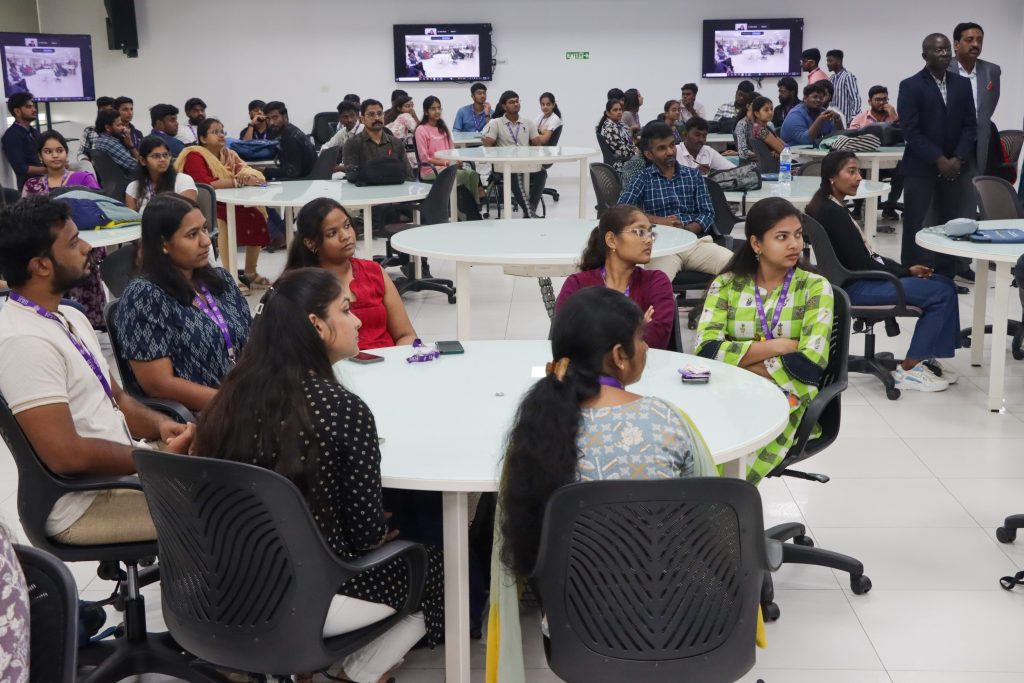
The second keynote address was delivered by Dr Syed Sadiq, a UN Women Representative from Kyrgyzstan. He commended the Paari School of Business and ICSSR for their dedication to advancing women’s rights and higher-education career opportunities. Reflecting on global progress since the first International Women’s Day in 1911, he highlighted achievements like equal voting rights, leadership opportunities, and establishing landmark treaties like the UN CEDAW (Convention on the Elimination of All Forms of Discrimination Against Women).
Despite these advancements, Dr Syed spoke about the persistent challenges women face in achieving equal pay, breaking barriers to leadership, and addressing workplace discrimination. He emphasised the need for gender-inclusive policies in higher education, targeted funding, mentorship programs, and stronger laws to combat harassment and discrimination. His “Change the Trend” and “Women Deserve More” statements were inspiring. He also discussed how systemic efforts that align with the Sustainable Development Goals (SDGs) can bring meaningful change to ensure no one is left behind.
The two-day conference also had various sessions on the barriers and biases that lead to the underrepresentation of women in leadership roles. The event concluded with a felicitation ceremony where both speakers were awarded a memento in appreciation of their remarkable sessions as keynote speakers.
Continue reading → - 3-Day Conference on “From Big Bang to Now” Concludes January 27, 2025
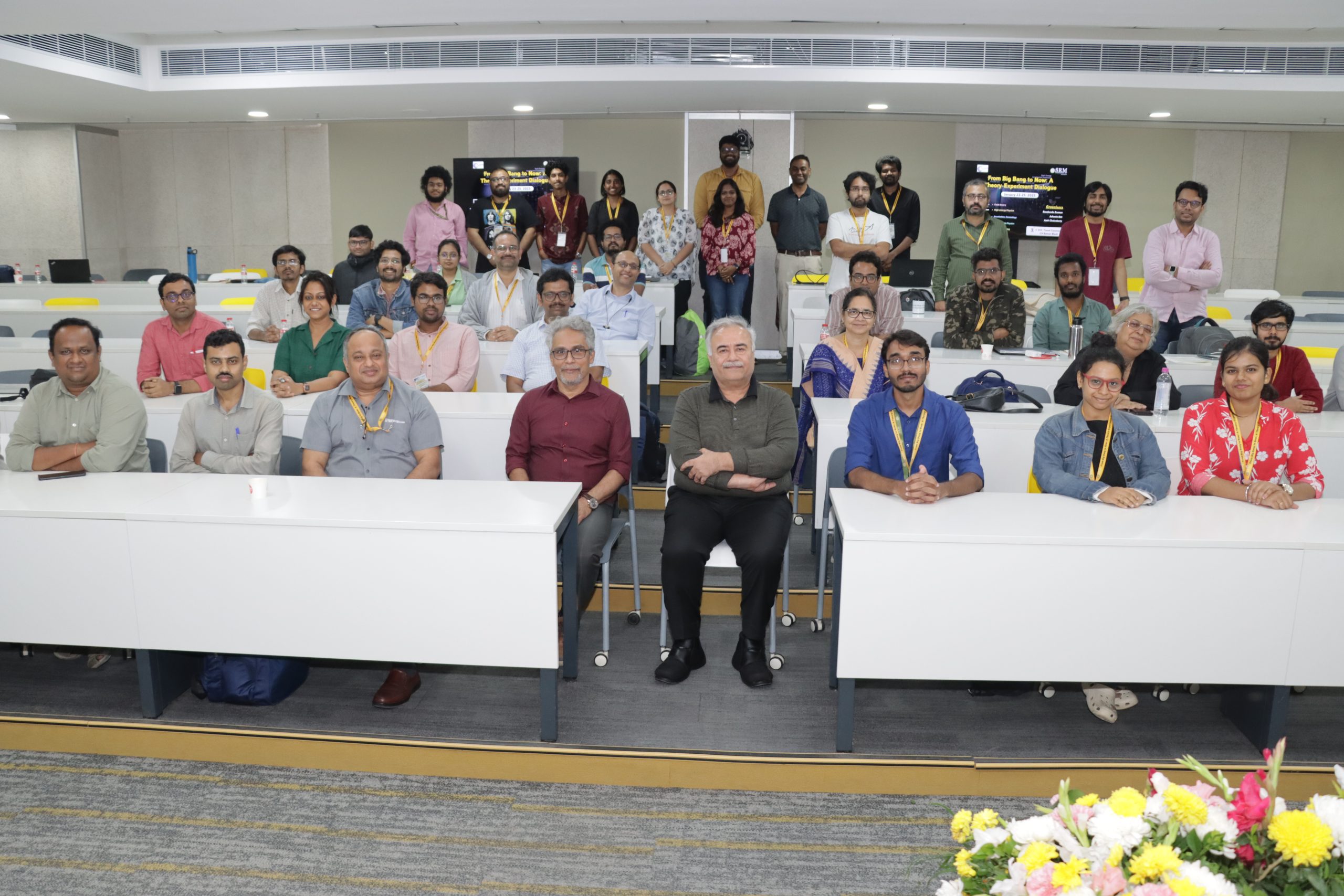 The Department of Physics organised a 3-day conference on “From Big Bang to Now : A Theory-Experiment Dialogue.” The event witnessed the presence of – Prof. Ranjit Thapa, Dean-Research; Dr C V Tomy, Dean-School of Engineering and Sciences, Dr Pranab Mandal, Head – Department of Physics, Prof. Sreerup Raychaudhuri along with Assistant Professors Dr Ashmita Das, Dr Basabendu Barman and Dr Amit Chakraborty.
The Department of Physics organised a 3-day conference on “From Big Bang to Now : A Theory-Experiment Dialogue.” The event witnessed the presence of – Prof. Ranjit Thapa, Dean-Research; Dr C V Tomy, Dean-School of Engineering and Sciences, Dr Pranab Mandal, Head – Department of Physics, Prof. Sreerup Raychaudhuri along with Assistant Professors Dr Ashmita Das, Dr Basabendu Barman and Dr Amit Chakraborty.As part of the inaugural address Dr C V Tomy highlighted the varsity’s prowess in terms of its accomplishments for a relatively young University, he stated that the varsity’s H-index of 59 reflects its significant global impact, the department of physics has also been the FIST sponsored Department among many other departments in the university.
Prof. Ranjith Thapa in his address stated, “SRM University-AP is a self-reliant institution, generating its own resources to fund cutting-edge research and education,” he also welcomed students to be a part of the academic community at SRM AP.
The Department head, Dr Pranab Mondal stated, “Since the inception we have grown tremendously as a department and as a university, both in terms of academic output and research impact. We also focus on actively collaborating with other departments to focus on not just research but also on advancing higher education and have strived to make the department what it is today.”
Prof. Sreerup Rayachaudhuri, visiting professor at the varsity and former professor at the TIRF said, “There are 4 categories of universities in India, the IITs, the private universities, the government universities and research institutes. Although SRM AP is a private university, it strongly encourages research, the very existence of this conference today, exemplifies the varsity’s commitment to fostering research culture.”
The conference also featured engaging presentations and lectures by students and faculty from various prestigious institutions across India. The event served as a platform for knowledge exchange, and networking, further strengthening SRM University-AP’s reputation as a hub for academic and research excellence.
The 3-day conference concluded with a renewed commitment to spreading knowledge in the field theory, high-energy physics, Astroparticle physics and Machine Learning, ensuring that SRM University-AP continues to contribute significantly to global scientific progress.
Continue reading → - Student Athelete Deepthi Jeevanji Felicitated for Winning the Arjuna Award January 27, 2025

SRM University-AP honoured the accomplishments of its student and Paris Paralympian, Ms Deepthi Jeevanji, who is a recipient of the Arjuna Award this year on January 24, 2025. Deepthi, a student of commerce at the Paari School of Business, represented India at the Paris Paralympics 2024 in the 400-meter T20 event and secured a bronze medal, becoming the first intellectually impaired Indian athlete to win a Paralympic medal.
The felicitation ceremony featured Vice Chancellor Prof. Manoj K Arora, Registrar Dr R Premkumar, Director of Campus Life and Maintenance and Director I/C of Sports, Mr Anup Suryavanshi and Former IIT Madras Faculty, Prof. N Siva Prasad presented Ms Jeevanji with award cheques of rupees twenty-five lakh for her Paralympic success and an additional fifteen lakh rupees for winning the Arjuna Award.
The event served as a platform to encourage aspiring students to pursue sports and consider it as a career option. During the ceremony, Deepthi expressed her gratitude, stating, “It is an immense honour to represent my country on such a prestigious global platform. The support from the management, staff, and my teachers at SRM University-AP played a crucial role in helping me achieve success.”

Vice Chancellor Prof. Manoj K Arora highlighted the importance of sports in education and the university’s commitment to fostering a culture of excellence. He stated, “We are proud of her achievement and hope she participates in the next Paralympics too, bringing gold to the country.” He also emphasised that the university is here to provide any form of support for her way forward in sports. Registrar Dr R Premkumar acknowledged Deepthi’s remarkable accomplishment and expressed pride in her historic success.
Director – Campus Life and Maintenance and Director I/C of Sports, Mr Anup Singh Suryavanshi, mentioned in the press meeting that followed, SRM University-AP has allocated seventy lakh rupees to encourage its high-performing students in sports. He noted that the university’s sporting infrastructure is on par with international standards and welcomes students from across the country to join its Sports Department.
The felicitation event also saw the announcements of the university’s upcoming National-Level Sports Fest, UDGAM 2025 which will see participation from over 3,200 students from across the country. Arjuna Awardee Ms Deepthi Jeevanji unveiled the event brochure to the members of the media.
Continue reading → - 76th Republic Day Celebrations: Student-Athlete and Olympian Jyotika Sri Dandi Rewarded with Cash Prize January 27, 2025
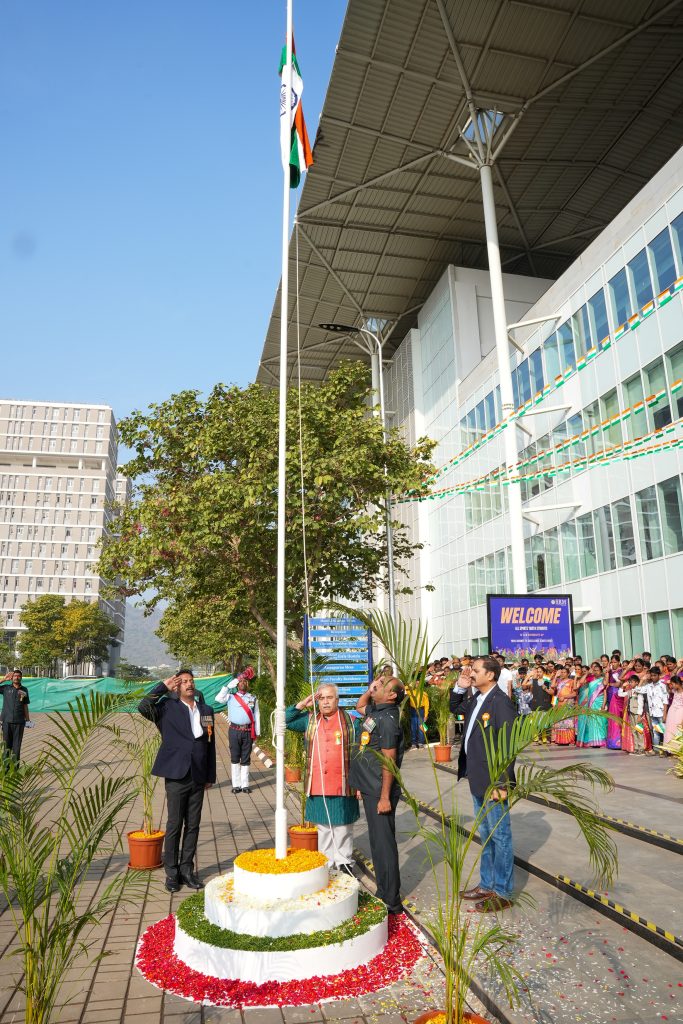
SRM University-AP honoured the 76th Year of India as a Republic with regal celebrations at the campus. Vice Chancellor Prof. Manoj K Arora hoisted the flag in the presence of Registrar Dr R Premkumar, Deans and Directors, faculty, staff and students, followed by a parade by the security staff of the university. Ms Jyotika Sri Dandi, student of Easwari School of Liberal Arts who represented the Indian team at the Women’s 4x400m Relay for the Paris Olympics 2024, was also present for the occasion.
In his address, Prof. Manoj K Arora spoke about the country’s golden heritage and the battle for freedom led by our freedom fighters and visionary leaders, which led to the momentous victory of Purna Swaraj. He underscored the significance of our Constitution representing the values that unite the diverse nation. “Our country has developed in leaps and bounds with our pivotal position on the global economic front, achievements in education and sports, and our advanced space programme. India is on its way to becoming a developed nation by 2047, and we must strive together as citizens to achieve this inclusive vision,” stated Prof. Arora in his address. He also briefed on the university’s stellar growth in academics, research and innovation, entrepreneurial startups, infrastructure and the plan for the upcoming year.
The celebration also witnessed the felicitation of the student-athlete and Olympian, Ms Jyotika Sri Dandi, who participated in the Paris Olympics 2024. The university awarded her a reward cheque of Rs 20 Lakhs for her remarkable contribution to Indian sports and her alma mater. In her address of gratitude, she stated, “SRM University-AP provided me with immense support for my academics with scholarships and the best resources for training. With two Olympians already in its fold, I am sure that in 10 years we will harbour the best contingent of athletes and academicians among all Indian universities.”
Pro-Chancellor Dr P Sathyanarayanan sanctioned Rs 70 lakh to be awarded to students who have won various national and inter-university sports championships. Cash prizes ranging from Rs 15,000 to Rs 1,00,000 were awarded to student-athletes for their exemplary sports performances during the event. Faculty and staff who have rendered five years of service to the university were also honoured with a memento and certificate in recognition of their contribution to the university’s development. The Republic Day celebrations concluded with various cultural programmes by students celebrating the diversity of the great nation.
Continue reading → - SRM AP Partners with Uniglobus Electrical and Electronics Pvt. Ltd. for EC-less LED Lighting Research January 24, 2025

In a significant stride towards advancing sustainable energy technologies, SRM University-AP has signed an Memorandum of Understanding (MoU) with Uniglobus Electrical and Electronics Pvt. Ltd. The collaboration aims to develop cutting-edge EC-less LED lighting systems through a joint research initiative. The partnership was formalised following an exploratory visit by Uniglobus representatives, Mr Gajanan Inamdar and Mr Saurabh Maheta, to SRM AP. During their visit, they engaged in extensive discussions with the university faculty, identifying EC-less LED drivers as a promising area for impactful research.
Dr Ramanjaneya Reddy Udumula, Assistant Professor from the Department of Electrical and Electronics Engineering, will lead this innovative project as the Principal Investigator. Highlighting the significance of the collaboration, he noted, “This research initiative will address critical challenges in energy-efficient lighting while fostering a bridge between academic insights and industrial expertise.”
Uniglobus has also invited Dr Udumula to visit its state-of-the-art facilities to gain an in-depth understanding of their advanced product line. This visit underscores the mutual commitment to fostering a symbiotic relationship between academia and industry, paving the way for groundbreaking technological advancements.
Key figures instrumental in making this collaboration a reality include Vice Chancellor Prof. Manoj K. Arora, Prof. Ranjit Thapa, Dean of Research; Prof. Vinod Kumar G S, Associate Dean of the Technology Transfer Cell; and Prof. C.V. Tomy, Dean of the School of Engineering and Applied Sciences (SEAS). Their collective efforts, alongside the support of Mr BS Praveen from Uniglobus, have laid the foundation for this transformative partnership.
The project focuses on addressing critical global challenges associated with energy sustainability and efficiency. With the rapid industrial growth and increasing global population driving energy demand, the limitations of conventional energy sources have become a pressing concern. Governments and industry leaders worldwide are calling for innovative solutions to promote energy-saving and sustainable technologies.

A Game-Changing Innovation
The research aims to develop an Electrolytic Capacitor (EC)-less, ripple-free LED driver system. Unlike conventional LED drivers, this system employs a DC-DC converter as a power factor correction (PFC) unit and a bi-directional buck-boost converter (BDC) to eliminate second harmonic ripples. This configuration simplifies control mechanisms while ensuring high power factor and reduced total harmonic distortion, delivering a steady DC current to the LED load.
Towards a Sustainable Future
This collaboration marks a significant milestone in addressing sustainability challenges through innovation. By merging the academic expertise of SRM University-AP with the industrial insights of Uniglobus Electrical and Electronics Pvt. Ltd., the partnership seeks to deliver impactful solutions for a greener, more sustainable future.
The MoU underscores SRM University-AP’s commitment to fostering innovation through strategic collaborations, positioning the institution at the forefront of research and technological development in energy efficiency. Both partners look forward to a fruitful and enduring collaboration that promises to benefit society at large.
Continue reading → - The Key to a Transformative Future – Systems Engineering Summit 2025 at SRM AP January 24, 2025

“The future is going to be a system of systems,” – Mr Dasari Ramakrishna, CEO & MD of Efftronics Systems Pvt. Ltd. at the Systems Engineering Summit 2025 hosted by SRM University-AP.
SRM University-AP kicked off the prestigious Systems Engineering Summit 2025 (SES 2025) on January 23, 2025, partnering with Efftronics Systems Pvt. Ltd., INCOSE India, IEEE Systems Council, Confederation of Indian Industry (CII) and the Information Technology Association of Andhra Pradesh (iTAAP). This two-day summit, to empower the next generation of system engineers, is designed as an outreach initiative to introduce students, faculty, and industry professionals to fundamental concepts, techniques, and exciting career thoughts in systems engineering.
Vice Chancellor, Prof. Manoj K Arora remarked, “Systems Engineering is a highly interdisciplinary field that overarches all branches of engineering and management disciplines. The SES 2025 is an informative platform for young engineers to understand how systems engineering drives innovation in today’s complex world.”
This summit brought together thought leaders and industry practitioners from different sectors, such as aerospace, automotive healthcare, defence, and industry manufacturers, for an array of keynote sessions and panel discussions on systems engineering as a key to navigating the transforming world. Mr Dasari Ramakrishna of Efftronics Systems Pvt Ltd opined that Systems Engineering provides exceptional aspirational directions and career thoughts. He said that in this rapidly evolving world, automation with a system of systems integration is the future, and it is time to introduce the concept into the curriculum of higher educational institutions.
An MoU was signed between SRM University-AP and Efftronics Systems Pvt. Ltd. to ensure active industry participation in academia, bridging the gap between the classroom and the workforce. SRM University-AP and the other participating universities, VIT-AP University, Vignan University, Siddhartha Academy of Higher Education, and Acharya Nagarjuna University, also signed an MoU with INCOSE India, exploring various opportunities to ensure the academic curriculum of the universities are made industry-ready.

Dr Yogananda Jeppu, Executive Committee Member – Academia, INCOSE India, Technical Fellow and Systems Architect – Boeing, stated, “The collaboration between industries and educational universities is the driving force of innovation. In a world of interconnectedness and complexity, systems engineering is the interdisciplinary field that will break the silos and bring innovation through its methodology.”
Notable dignitaries from industry, academia and the government including Smt. Lakshmi Mukkavilli, President, IT Association of Andhra Pradesh, MD – Patra India BPO Services; Dr S V Kota Reddy, Vice Chancellor, VIT-AP University; Prof. Paruchuri Venkateswara Rao, Vice Chancellor, Siddhartha Academy of Higher Education; Prof. K Gangadhara Rao, Vice Chancellor, Acharya Nagarjuna University; Cmde. Dr M S Raghunathan, Registrar, Vignan University; Dr Maheswar Dwivedy, Associate Dean – Academia-Industry Relations and Professional Internships, SRM AP also shared their insights on the significance of this prestigious summit.
The Systems Engineering Summit 2025 organised as a joint initiative by SRM AP and various organisations, proved to be not just a summit but a call for action. The summit inspired a meaningful dialogue to create a roadmap for technological advancements in systems engineering for a more equitable and more sustainable society.
Continue reading →










































